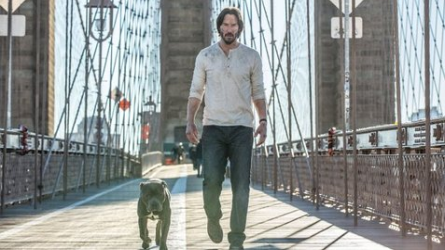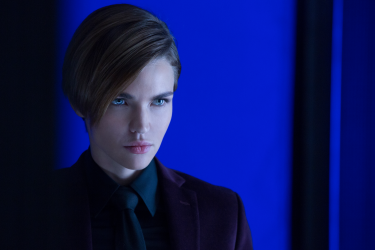The thing about action movies is that when they’re done well, they look effortless. In fact, a common critical sneer against the genre is that anyone who can slap together a few car chases, gun fights and explosions can do it—and by implication, “serious” drama films are much harder, requiring “real” acting and “real” character development and so on. But this is exactly backwards.
Drama is easy. You put a recognizable character in a recognizable situation and you’re halfway to the goal line. Think about your own standards when watching a drama: A single actor can carry a drama, even if it’s not very well written, shot or scored. Comedy is probably the hardest. But action is a close second, since the cardinal sin of both is boredom, and if you’re not laughing—or thrilled!—the movie is failing.

The original concept for this tattoo was “OSORES ODIET”
And if there’s any evidence of the truth of this, it’s that there just aren’t that many good action movies (by percentage). And this led to the pleasant surprise of John Wick: Chapter 2, widely regard as substantially better than the first (which itself was very well regarded).
I had snuck off to see the first one without The Boy, because he was a little too jaded by too many glowingly positive reviews of mediocre comic book films to be swayed, but both he and The Flower were with me for Chapter 2 because you really don’t need to see the first one to get this. (Plot summary for movie 1: Bad guys steal John Wick’s car and kill his dog. John Wick Kills All The People.) The producers found a loose thread from the first movie regarding Wick’s car to launch into the sequel, but this is more thankfully more of a catalyst to a new story than an attempt to keep the old one going.
In Chapter 2, someone Wick gave a marker to in order to get out of the underworld life, calls it in. Santino is an Italian mobster who wants Wick to kill his sister, who’s the head of the crime family, so that Santino can take it over. Complications ensue.

The dog looks nervous. “Complications? What complications?”
The thing that made the first movie so enjoyable was that beyond competent action sequences (including a command of the space in which the action takes place that is sorely missing from most modern action films), the film hinted at an epic underworld civilization with its own set of rules. An overeager assassin breaking the rules was a major plot point, in fact. (I credit this to a Hong Kong influence, though I haven’t researched it.) So, it’s not just 2 hours of Keanu Reeves shooting at people, which might get tiring no matter how well Mr. Reeves does it.
The second film fleshes this out in an almost Lankhmarian way: Besides Ian McShane reprising his role as the hotel owner, we’re introduced to The Bowery King (essentially the king of the beggars), played by Lawrence Fishburne in a nice Matrix callback. In this situation, Wick finds Santino leveraging the Underworld’s rules against him over and over again. (This movie reinforced my belief that everyone in New York City is a criminal. ) With someone skilled at manipulating the civilization’s rules, Wick is in a paranoid situation from which there is no apparent escape.

“Take the blue pill and your action franchise will suck. Take the red pill and…wait, I may have that backwards.”
There will be a sequel of course. Like many second movies in a trilogy, the end here demands it. It’s probably the fastest 2 hours I’ve spent in a theater since Indiana Jones and the Temple of Doom so I’m not likely to mind.
But beyond action (and lots of dead people) the movie is rich with characters that it draws better than a lot of dramas—and does so very succinctly. Claudia Gerini (The Passion of the Christ) has just a short time on screen, but it’s a memorable time. The Heavy in this film is played by Ruby Rose (in the latest installments of XXX and Resident Evil this year), who manages to not be a tired tiny-girl-heavy cliché somehow. You can just tell when a movie really cares—it uses characters to paint a picture, even when they’re small parts. (Think the candy-stealing terrorist in Die Hard, e.g.) It was nice to see house favorite Peter Serafinowicz (of the Cornetto trilogy and the recent “Tick” reboot), and of course Ian McShane just has to sit around and intone to make magic happen.
Speaking of caring, the cinematography is great. Just like a film can do more with characters than have them recite lines that advance the plot, and camerawork can do more than communicate one guy shooting or punching another, the right setting and lighting can do more than provide a place for said punching and shooting and talking to happen.
The kids enjoyed it. I also enjoyed it but I didn’t find myself quite as captivated as with the first film, perhaps because my expectations were lower for that. John Wick: Chapter 2 is one of those movies that makes action look easy.

She speaks sign language, but only one sign.
